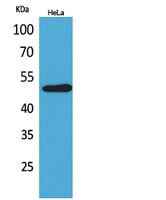Total EMMPRIN Cell-Based Colorimetric ELISA Kit
- Catalog No.:KA3594C
- Applications:ELISA
- Reactivity:Human;Mouse;Rat
- Gene Name:
- BSG
- Human Gene Id:
- 682
- Human Swiss Prot No:
- P35613
- Mouse Swiss Prot No:
- P18572
- Rat Swiss Prot No:
- P26453
- Storage Stability:
- 2-8°C/6 months
- Other Name:
- Basigin (5F7) (Collagenase stimulatory factor) (Extracellular matrix metalloproteinase inducer) (EMMPRIN) (Leukocyte activation antigen M6) (OK blood group antigen) (Tumor cell-derived collagenase stimulatory factor) (TCSF) (CD antigen CD147)
- Detection Method:
- Colorimetric
- Background:
- function:Plays pivotal roles in spermatogenesis, embryo implantation, neural network formation and tumor progression. Stimulates adjacent fibroblasts to produce matrix metalloproteinases (MMPS). May target monocarboxylate transporters SLC16A1, SLC16A3 and SLC16A8 to plasma membranes of retinal pigment epithelium and neural retina. Seems to be a receptor for oligomannosidic glycans. In vitro, promotes outgrowth of astrocytic processes.,induction:Enriched on the surface of tumor cells. Up-regulated in gliomas. Its expression levels correlate with malignant potential of the tumor.,online information:Blood group antigen gene mutation database,PTM:N-glycosylated.,similarity:Contains 1 Ig-like C2-type (immunoglobulin-like) domain.,similarity:Contains 1 Ig-like V-type (immunoglobulin-like) domain.,subcellular location:Colocalizes with SLC16A1 and SLC16A8 (By similarity). Identified by mass spectrometry in melanosome fractions from stage I to stage IV.,subunit:Forms homooligomers in a cis-dependent manner on the plasma membrane. Forms a complex with MMP1 at the tumor cell surface. Interacts with SLC16A1 and SLC1A3; probably a BSG dimer is associated with a monocarboxylate transporter dimer. Interacts with ATP1B2, MAG and L1CAM (By similarity). Interacts with AJAP1.,tissue specificity:Present only in vascular endothelium in non-neoplastic regions of the brain, whereas it is present in tumor cells but not in proliferating blood vessels in malignant gliomas.,
- Function:
- placenta development, maternal placenta development, reproductive developmental process, pyruvate metabolic process, cell surface receptor linked signal transduction, female pregnancy, embryo implantation, response to endogenous stimulus, response to hormone stimulus, response to organic substance, response to inorganic substance, response to metal ion, odontogenesis of dentine-containing tooth, odontogenesis, response to peptide hormone stimulus, response to mercury ion, decidualization, response to cAMP,
- Subcellular Location:
- Melanosome . Identified by mass spectrometry in melanosome fractions from stage I to stage IV. .; [Isoform 1]: Cell membrane ; Single-pass type I membrane protein . Photoreceptor inner segment . Cell projection, cilium, photoreceptor outer segment .; [Isoform 2]: Cell membrane ; Single-pass type I membrane protein . Endosome . Endoplasmic reticulum membrane ; Single-pass type I membrane protein . Basolateral cell membrane ; Single-pass type I membrane protein .; [Isoform 3]: Cell membrane ; Single-pass type I membrane protein .; [Isoform 4]: Cell membrane ; Single-pass type I membrane protein .
- Expression:
- [Isoform 1]: Retina-specific (PubMed:25957687). Expressed in retinal cone photoreceptors (at protein level) (PubMed:25957687). ; [Isoform 2]: Expressed in erythrocytes (at protein level) (PubMed:26195724, PubMed:28409866). Highly expressed in melanoma cell lines (at protein level) (PubMed:11992541). Highly expressed in the heart, kidney, skeletal muscle and testis (PubMed:21536654). ; [Isoform 3]: Highly expressed in the bone marrow, fetal liver, lung, testis and thymus. ; [Isoform 4]: Highly expressed in the bone marrow, fetal liver, lung, testis and thymus.
- June 19-2018
- WESTERN IMMUNOBLOTTING PROTOCOL
- June 19-2018
- IMMUNOHISTOCHEMISTRY-PARAFFIN PROTOCOL
- June 19-2018
- IMMUNOFLUORESCENCE PROTOCOL
- September 08-2020
- FLOW-CYTOMEYRT-PROTOCOL
- May 20-2022
- Cell-Based ELISA│解您多样本WB检测之困扰
- July 13-2018
- CELL-BASED-ELISA-PROTOCOL-FOR-ACETYL-PROTEIN
- July 13-2018
- CELL-BASED-ELISA-PROTOCOL-FOR-PHOSPHO-PROTEIN
- July 13-2018
- Antibody-FAQs



